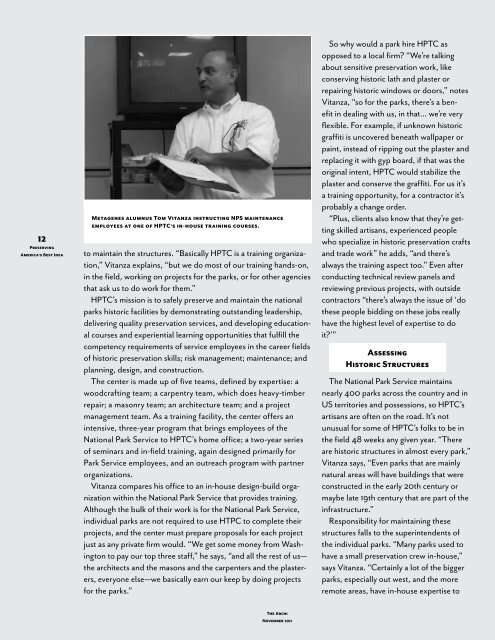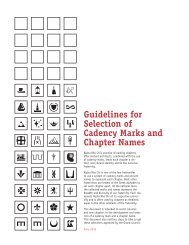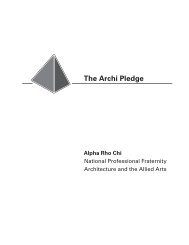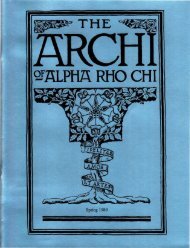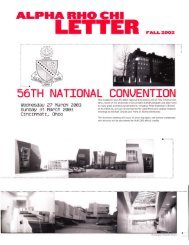The Archi - November 2011 - Alpha Rho Chi
The Archi - November 2011 - Alpha Rho Chi
The Archi - November 2011 - Alpha Rho Chi
You also want an ePaper? Increase the reach of your titles
YUMPU automatically turns print PDFs into web optimized ePapers that Google loves.
12<br />
Preserving<br />
America’s Best Idea<br />
Metagenes alumnus Tom Vitanza instructing NPS maintenance<br />
employees at one of HPTC’s in-house training courses.<br />
to maintain the structures. “Basically HPTC is a training organization,”<br />
Vitanza explains, “but we do most of our training hands-on,<br />
in the field, working on projects for the parks, or for other agencies<br />
that ask us to do work for them.”<br />
HPTC’s mission is to safely preserve and maintain the national<br />
parks historic facilities by demonstrating outstanding leadership,<br />
delivering quality preservation services, and developing educational<br />
courses and experiential learning opportunities that fulfill the<br />
competency requirements of service employees in the career fields<br />
of historic preservation skills; risk management; maintenance; and<br />
planning, design, and construction.<br />
<strong>The</strong> center is made up of five teams, defined by expertise: a<br />
woodcrafting team; a carpentry team, which does heavy-timber<br />
repair; a masonry team; an architecture team; and a project<br />
management team. As a training facility, the center offers an<br />
intensive, three-year program that brings employees of the<br />
National Park Service to HPTC’s home office; a two-year series<br />
of seminars and in-field training, again designed primarily for<br />
Park Service employees, and an outreach program with partner<br />
organizations.<br />
Vitanza compares his office to an in-house design-build organization<br />
within the National Park Service that provides training.<br />
Although the bulk of their work is for the National Park Service,<br />
individual parks are not required to use HTPC to complete their<br />
projects, and the center must prepare proposals for each project<br />
just as any private firm would. “We get some money from Washington<br />
to pay our top three staff,” he says, “and all the rest of us—<br />
the architects and the masons and the carpenters and the plasterers,<br />
everyone else—we basically earn our keep by doing projects<br />
for the parks.”<br />
So why would a park hire HPTC as<br />
opposed to a local firm? “We’re talking<br />
about sensitive preservation work, like<br />
conserving historic lath and plaster or<br />
repairing historic windows or doors,” notes<br />
Vitanza, “so for the parks, there’s a benefit<br />
in dealing with us, in that… we’re very<br />
flexible. For example, if unknown historic<br />
graffiti is uncovered beneath wallpaper or<br />
paint, instead of ripping out the plaster and<br />
replacing it with gyp board, if that was the<br />
original intent, HPTC would stabilize the<br />
plaster and conserve the graffiti. For us it’s<br />
a training opportunity, for a contractor it’s<br />
probably a change order.<br />
“Plus, clients also know that they’re getting<br />
skilled artisans, experienced people<br />
who specialize in historic preservation crafts<br />
and trade work” he adds, “and there’s<br />
always the training aspect too.” Even after<br />
conducting technical review panels and<br />
reviewing previous projects, with outside<br />
contractors “there’s always the issue of ‘do<br />
these people bidding on these jobs really<br />
have the highest level of expertise to do<br />
it?’”<br />
Assessing<br />
Historic Structures<br />
<strong>The</strong> National Park Service maintains<br />
nearly 400 parks across the country and in<br />
US territories and possessions, so HPTC’s<br />
artisans are often on the road. It’s not<br />
unusual for some of HPTC’s folks to be in<br />
the field 48 weeks any given year. “<strong>The</strong>re<br />
are historic structures in almost every park,”<br />
Vitanza says, “Even parks that are mainly<br />
natural areas will have buildings that were<br />
constructed in the early 20th century or<br />
maybe late 19th century that are part of the<br />
infrastructure.”<br />
Responsibility for maintaining these<br />
structures falls to the superintendents of<br />
the individual parks. “Many parks used to<br />
have a small preservation crew in-house,”<br />
says Vitanza. “Certainly a lot of the bigger<br />
parks, especially out west, and the more<br />
remote areas, have in-house expertise to<br />
<strong>The</strong> <strong>Archi</strong><br />
<strong>November</strong> <strong>2011</strong>


